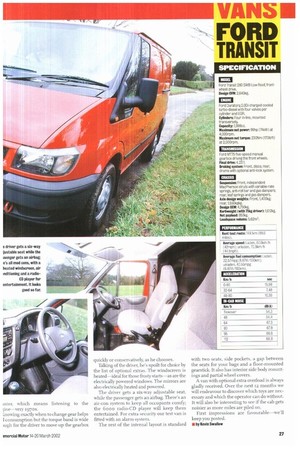FORD TRANSIT 280 SWB
Page 26

Page 27

If you've noticed an error in this article please click here to report it so we can fix it.
!PRICE AS TESTED: 113,000 (ex-VAT) plus £1,950 (exVAT) for optional extras*. ENGINE: 2.0 litres, 99hp (74kW). GVW: 2,640kg. PAYLOAD: 953kg. FUEL CONSUMPTION (LADEN): 32.57mpg (8.671it/100km). AVERAGE SPEED (LADEN): 67.6km/h (42mph).
*Optional extras: Electrically powered and heated wing mirrors, £50: sixway adjustable drivers seat, n/c; air-con, £800; 2700 rear doors. n/c; powered and heated windows. £75; heated windscreen, £75; 6000 radioCD player. £150: front passenger seat airbag. £150: traction control, £325; alarm, £150: body side mountings, no charge: partial wheel cover. £25; steel bulkhead, £180. Total: £1,950 (ex-VAT).
Tbe hype surrounding the allnew Ford Transit was considerable, to say the least. But since the excitement died down Ford has maintained its domination of the UK market so the newcomer must have a lot going for it. To find out how much, CM will be running a Transit 280 for a full 12 months.
During that time we aim to put 20-30,000 miles on the clock, with regular fuel runs around our Kent test route. Well also be assessing how well the vast array of optional extras help the driving experience.
What makes this low-roof Transit 280 significant is its front-wheel-drive, transversely mounted 2.0-litre charge-cooled turbo-diesel, complete with exhaust gas recirculation (EGR) and computer-controlled fuel injection. 1 he 16alye straight four produces 99hp at 4,000rpm with 200Nm of torque at 2,3oorpm. Transmission is the five-speed manual gearbox.
Ford has developed its front and rear-wheel drive Transits with a huge overlap of components. The FWD's obvious advantage is a weight saving of some 130kg and a loadbed that is 2omm lower than the RWD variant. These might not be large figures but they can make a difference in getting an extra delivery on board and handballing loads. Load access is helped by a nearside sliding door and rear doors that open to 27e (one of several optional extras).
211 1 A I I, The z.8-tonne van market is ferociously competitive these days with the Renault Trafic/
Vauxhall Vivaro and the well-establis Mercedes-Benz Vito among the front-i ners, not to mention the high-payload alte lives from a number of manufacturers.
The 280 SWB Transit is one step from bottom of the range. It has a 2,640kg G and 953kg payload—very competitive. Trafic/Vivaro is 940kg plus a sandwich and the Vito is 5kg shy of a tonne.
As any operator will testify, no vehicle reach its maximum productivity until it is in, but that didn't stop CM putting our Tra through its first fuel run with barely miles on the dock, just to see what happei In the event the figures were pretty good.
Our first (laden) was completed 32.6mpg at an average speed of 67.6kr (42mph). Compare that with the 38.811 returned by a Vito with more than 3o,c miles on the clock.
A Renault Trafic I.9dCi 8o achie 36.2mpg while the more powerful Vaux1 Vivaro 1.9DTI 99hp version achie 31.6 mpg, both with relatively low mileage.
On the road
The Transit comes with traction con (another optional extra) which improves h dling through tight corners and roundalx without compromising momentum or los any grip. Braking is also significai enhanced by ABS.
Our only gripe concerns the lack of a
inter, which means listening to the ;ine—veryi97os.
:nowing exactly when to change gear helps 1 consumption but the torque band is wide )ugh for the driver to move up the gearbox quickly or conservaiively, as he chooses.
Talking of the driver, he's spoilt for choice by the list of optional extras. The windscreen is heated—ideal for those frosty starts—as are the electrically powered windows. The mirrors are also electrically heated and powered.
The driver gets a six-way adjustable seat, while the passenger gets an airbag. There's an air-con system to keep all occupants comfy; the Gooc, radio-CD player will keep them entertained. For extra security our test van is fitted with an alarm system.
The rest of the internal layout is standard with two seats, side pockets, a gap between the seats for your bags and a floor-mounted gearstick. It also has interior side body mountings and partial wheel covers.
A van with optional extra overload is always gladly received. Over the next 12 months we will endeavour to discover which toys are necessary and which the operator can do without. It will also be interesting to see if the cab gets noisier as more miles are piled on.
First impressions are favourable—we'll keep you posted.
• by Kevin Swallow
















































































































































